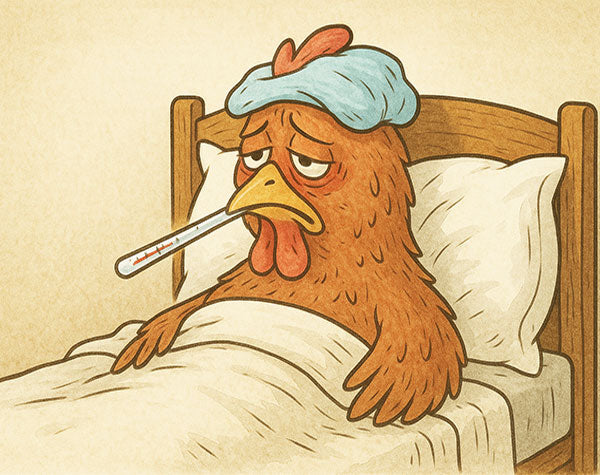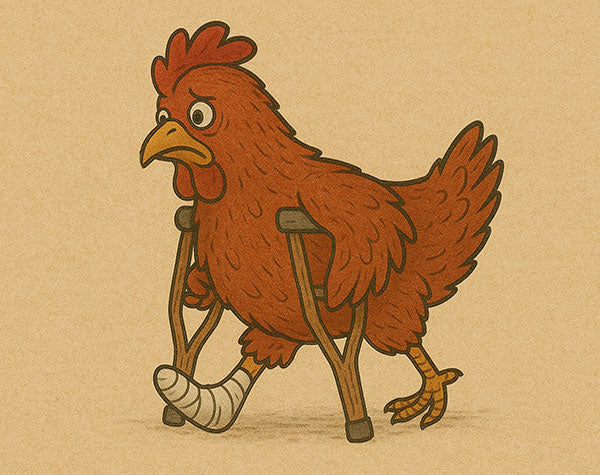🐓 Chicken Health Compendium
This page covers: Parasites – Inside & Out.
Part of our Chicken Health Hub - a guide to identifying, preventing, and treating poultry health issues.
Parasites are the uninvited guests every chicken keeper dreads - tiny, persistent, and annoyingly good at hiding. Whether it’s lice on feathers, mites in the coop, or worms in the gut, these freeloaders can cause serious discomfort and health issues if left unchecked. With a little vigilance and the right prevention measures, you can keep your flock parasite-free and in peak condition.
In this section: Worms · Coccidiosis · Canker · Blackhead Disease · Lice · Red Mite · Northern Fowl Mite · Depluming Mite · Scaly Leg Mite · Fleas
Worms (Internal Parasites)
Parasitic worms (roundworms, gapeworms, tapeworms, etc.) are common in poultry, usually inhabiting the digestive or respiratory tract. Most birds can live with a small worm burden, but it should be treated to avoid other problems. Read our blog about Poultry Worms Treat & Prevent and watch our videos About Chicken Worms.
Symptoms
- Weight loss
- Pale comb
- Diarrhoea
- Gasping (in gapeworm cases)
Prevention
- Stay vigilant with regular checks
- Regular faecal egg counts (e.g. Westgate Worm Test Kit)
- Rotate the ground to avoid build-up of parasites
- Keep the house and run clean and dry
- Limit contact with wild birds
Treatment
- Licensed wormers (e.g. Flubenvet/Flubendazole in the UK)
- Repeat as needed - suggest twice yearly
- Herbal wormers available for monthly use (e.g. Verm-X Liquid or Pellets)
- Consult a vet for persistent cases
Coccidiosis
A parasitic intestinal disease caused by protozoa (coccidia - single-cell micro-organisms). The coccidia parasite attaches itself to the gut lining and damages it, making it bleed. Common in very young birds, transmitted through droppings and damp bedding. Once infected, chicks and vulnerable birds can die within days without treatment. Read our blog about Coccidiosis.
Symptoms
- Bloody or watery droppings
- Pale combs and wattles
- Lethargy, hunching, ruffled feathers
- Poor appetite, weight loss
- Sudden death (in chicks or within ~9 days in adults)
Prevention
- Keep bedding clean and dry
- Medicated chick crumb (coccidiostat) for young birds
- Rotate their ground; avoid damp conditions
- Isolate age groups - don’t mix young with older birds
Treatment
- Anti-coccidial medication (Paracox, Coxoid with vet advice)
- Isolate sick birds
- Disinfect housing and equipment (e.g. Virkon S)
Canker (Trichomoniasis)
A protozoan parasite affecting the mouth and throat; more common in pigeons but can infect chickens.
Symptoms
- Yellow, cheesy, foul-smelling growths in the mouth
- Drooling or difficulty eating
- Head shaking
- Loss of appetite
Prevention
- Keep wild birds away from feeders/drinkers
- Clean and sanitise drinkers regularly
- Avoid stagnant/dirty water sources
Treatment
- Metronidazole or carnidazole (vet prescribed)
- Move birds to new, clean surroundings
- Disinfect housing and equipment with Virkon S
Blackhead Disease (Histomoniasis)
A protozoan infection mainly affecting turkeys but can also infect chickens, damaging the liver and intestines. Chickens may carry it without severe illness; turkeys are highly susceptible and will die.
Symptoms
- Yellow, foamy droppings
- Lethargy
- Drooping wings
- Increased thirst
Prevention
- Do not keep chickens and turkeys together
- Control worms in chickens (see Worms)
- Good hygiene, disinfection and litter management
Treatment
- No licensed treatment in the UK
- Natural remedies may help (unproven)
- Euthanise affected birds to prevent the spread
Lice (Body Lice)
External parasites that feed on skin debris, causing irritation. Not life-threatening, but causes discomfort, makes them under the weather and reduces laying. See our YouTube video Lice & Mites in Chickens.
Symptoms
- Constant preening, feather loss
- Red, sore skin
- Eggs (nits) at the feather base
- Small grey lice are visible on the skin
- Reduced egg production
Prevention
- Access to a dust bath
- Regular checks, especially in warm months
- Clean bedding and coop regularly
- Check the dark corners of the coop regularly
- Use Louse Powder or Diatomaceous Earth as a preventative
Treatment
- Poultry-safe louse powder for the coop (pyrethrum-based)
- Vets may recommend a spot-on treatment e.g. Harka-mectin
- Treat all birds and housing
- Repeat every 7–10 days
Red Mite
Tiny blood-sucking mites that hide in the coop by day and feed on birds at night, where they roost. Very common and hard to spot until numbers are high.
Read our blog, How to Get Rid of Red Mite, and The 9 Signs of Red Mite, and watch our Ask Phill video about Treating your Chicken Coop for Red Mite.
Symptoms
- Birds are reluctant to roost at night
- Pale combs, anaemia
- Drop in egg production
- Mites are visible under the perches
Prevention
- Weekly deep cleaning in summer
- Diatomaceous earth or mite powder in cracks and crevices
- Extra checks in hot, humid weather
Treatment
- Deep clean with poultry cleaners (e.g. Smite Liquid)
- Mite sprays (e.g. Nettex Total Mite Kill), mite powders and smoke bombs
- Treat birds with Battles Red Mite Powder or Diatomaceous Earth
Northern Fowl Mite
Blood-sucking brown mites that live permanently on the bird, even in winter. Larger than red mite; often seen on the head, comb, and body.
Symptoms
- Brown mites visible on the head or in the ear canal
- Scabbing, crusty skin, pale combs
- Anaemia, weight loss
- Scratching and eye damage from irritation
Prevention
- Isolate new birds
- Regular health checks
- Maintain good coop hygiene
- Dust with Diatomaceous Earth as a preventative
Treatment
- Poultry mite powders (e.g. Battles Red Mite Powder)
- Coop treatment with Battles Louse Powder
- Repeat after 7 days
- Vet may advise Harka-mectin spot-on drops
Depluming Mite
Mites that burrow under the skin around the feather quills, causing intense irritation and feather pulling. So named because they eat away at the quills (which are full of protein) and make feathers fall out.
Symptoms
- Feather pulling, loss of feathers and bald patches
- Red, inflamed skin
- Irritability or over-preening
Prevention
- Good hygiene
- Avoid overcrowding
- Regular treatment with a Mite Powder
- Isolate affected birds quickly
Treatment
- Harka-mectin spot-on (vet prescribed)
- Repeat to break the lifecycle
Scaly Leg Mite
Cnemidocoptes mutans mites burrow under leg scales, causing discomfort and raised, crusty scales. Usually brought in by wild birds, they live in the ground and infect the birds. Feather-legged birds are especially susceptible. Read our blog about Scaly Leg Mite and watch our video about How to Identify & Treat Scaly Leg Mite.
Symptoms
- Thickened, crusty legs with white deposits
- Raised/lifted scales causing irritation
- Lameness or reluctance to perch
Prevention
- Regular leg checks
- Quarantine new birds
- Keep coop/run clean and dry (e.g. Ground Sanitising Powder)
- Rotate to fresh ground regularly
- Limit wild bird contact
Treatment
- Soak legs in warm water
- Apply petroleum jelly or Scaly Leg Mite ointment
- Spray with a Scaly Leg Spray
- Ivermectin or Harka-mectin if vet advised
Fleas (Sticktight Flea)
Fleas are rare on chickens, but they would attach around the face and comb. Can be confused with other poultry mites.
Symptoms
- Black or brown specks on comb/wattles
- Irritation, scratching
- Feather loss around the head
- Lethargy, reduced egg laying
Prevention
- Clean bedding and nest boxes regularly
- Keep wild birds and rodents out of the coop
- Provide dust baths
Treatment
- Remove fleas with tweezers
- Apply poultry-safe insecticidal powder
- Treat the coop with insecticide or powder; repeat until gone
- - - - - -
More from the Chicken Health Compendium:
• Bacterial & Viral Infections
• Physical & Environmental Issues



